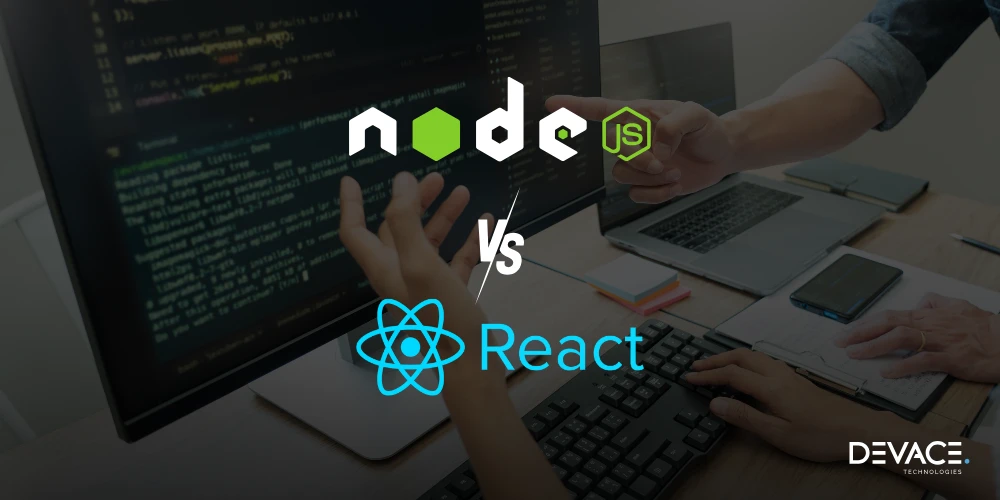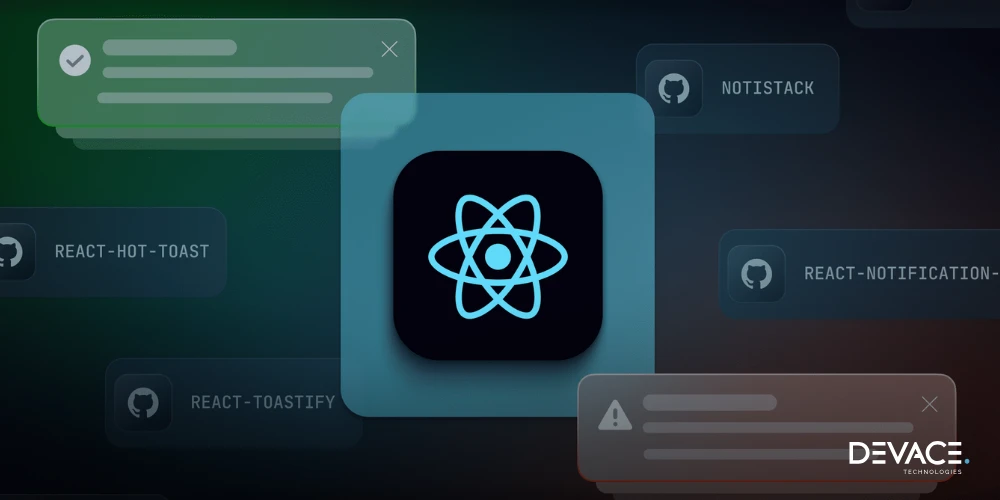For web development projects different frameworks of JavaScript are trusted by developers across the globe. Among these frameworks, Node.js and React.js are the most discussed ones. If you see Node.js vs React.js which framework is suitable for your project? The answer is both serve different purposes, and you can select the right one depending on project demands. This comprehensive guide will assist you in selecting the best fit.
A Basic Introduction
To get answers about what these frameworks are and how they are utilized in web development read the given details:
An Introduction to Node.js
Node.js is a runtime environment that enables developers to implement JavaScript code even outside the browser. It indicates that now developers are able to write server-side code in JavaScript which was previously available for browsers. Moreover, this framework was built on the V8 JavaScript engine (this engine was also utilized to power Google Chrome).
Some Key Features
Some important features of Node.js are jotted down here:
- Non-blocking I/O: Confirming high performance and scalability in heavy I/O applications with the help of non-blocking I/O operations.
- Lightweight and Efficient: Node.js is efficient and lightweight as it handles requests through a single-thread event loop.
- npm library: The largest software directory offering access to a wide variety of tools and open-source libraries.

Code Example
Here let’s have a look at a basic HTTP server:
const http = require(‘http’); // Import HTTP module
// Create a server
const server = http.createServer((req, res) => {
res.statusCode =200;
res.setHeader(‘Content-Type’, ‘text/plain’);
res.end(‘Hello, World!\n’);
});
// The server listens on port 3000
server.listen(3000, ‘127.0.0.1’,() => {
console.log(‘Server running at http://127.0.0.1:3000/’)
});
So, this basic server gives a response with ‘Hello World’ when you have access. Moreover, Node.js can handle multiple requests without being slowed down with the help of its non-blocking nature.
Looking for a smooth web development process for your upcoming project?
An Introduction to React.js
It is a JavaScript library that is mostly used to build user interfaces. To simplify the process of designing interactive UIs, this framework was created by Facebook. It focuses on and uploads only the essential components of a web page, in contrast with traditional web development approaches that load a full page. That’s why many organizations prefer to hire React.js developers for efficient UI development.
Some Key Features
Some important and useful features of React.js include virtual DOM, component-based architecture, and declarative syntax. Details for these features are given here:
- Virtual DOM: React opts for a virtual DOM to improve performance and reduce rendering instead of upgrading the DOM each time.
- Component-based Architecture: The development of reusable components is favored by React.js and these components can be combined well to create interactive and dynamic interfaces.
- Analytical Syntax: This framework makes it easier to comprehend how the UI must look according to the current state due to its analytical syntax.

Code Example
We are setting an example of how a React component can be designed:
import React, { useState } from ‘react’;
function Greeting() {
const [message, setMessage] = useState(“Hello, World!”);
return (
<div>
<h1>{message}</h1>
<button onClick= {( ) => setMessage(“Hello, React!”)}>Change Message</button>
</div>
);
}
export default Greeting;
This given example illustrates how React frameworks, particularly React.js, render a basic message and offer a button to dynamically update messages. When this button is clicked UIs get updated in a seamless manner.
Key Stats of Popularity
Both technologies Node.js and React.js are widely popular these days in the web development domain. Let’s figure out how popular these frameworks are among developers.
How much Popular is Node.js?
A developer survey of Stack Overflow states that Node.js is among those JavaScript frameworks that are widely adopted by developers in 2023. With this framework, developers create flexible backend systems. Its rich ecosystem and dynamic features like its non-blocking nature make it famous.
How much Popular is React.js?
According to the above-discussed survey stats, more than 40% of web developers have opted for React.js for front-end web development. Also, Facebook has adopted this framework due to its component-based architecture and virtual DOM. That’s why companies like Netflix and others prioritize React.js and mostly hire front-end developers for a smooth web development journey.
Comparison Table: Node.js Vs React.js
To have a quick overview of the difference between Node.js and React.js have a look at this table. It explains every possible difference between the two frameworks in detail starting from the nature of web development to all the pros and cons of selecting them.
| Features | Node.js | React.js |
|---|---|---|
| Type | Backend (Server-side) | Front-end (Client-side) |
| Primary Use | Building real-time apps, APIs, and backend logic | Designing interactive user interfaces (UIs) |
| Execution Environment | JavaScript runtime on server | JavaScript library in the browser |
| Learning curve | Moderate to steep needs an understanding of data-driven programming | Easy to moderate, particularly for JavaScript developers |
| Performance | Non-blocking, High, event driven I/O | Excellent, all due to virtual DOM |
| Ecosystem | npm | React libraries |
| Real-time Capabilities | Excellent (Websockets, Socket.io) | Restricted (React framework can interact with real-time services |
| The best fit for | Data management, server-side data operations, real-time applications | Reusable interface components |
| Tools for developers | npm, Debugger, and Node inspector | JSX, React developer tools |
| Caching | Caching of individual modules ensuring efficient driving time | Focused on DOM and code reusability |
| Benefits | Extensible Utilized for web development tasks Individual modules caching Horizontal and vertical scaling of applications Code can be converted into machine code through the V8 engine |
Easy testing of user interfaces Support for iOS and Android Offers front-end and server-side support Reusable code components Rapid debugging and virtual DOM |
| Microservices | Facilitates microservices | It’s difficult to write microservices in React.js |
| Drawbacks | Rather than liner blocking I/O, supports asynchronous programming | Difficult to stay updated with every new launch |
Node.js Vs React.js: A Detailed Comparison
To get a clear difference between both JavaScript frameworks let’s compare what is their role in web development. How they differ in performance and flexibility, integration and ecosystems, and some practical examples.
Node JS Vs React JS: Part in Web Development
Role of Node.js in Web Development
This framework is primarily opted for backend web development. It is also responsible for the management of data, handling server-side logic, authentication, API management, and a lot more. If your development projects need real-time processing and scalability, Node.js is the ideal choice. Moreover, developers can utilize JavaScript for both front-end and backend web development tasks.
Role of React.js in Web Development
The prime focus of React.js is the development of user interfaces and better user experience of a web application. Moreover, the interactive nature of the user interface is ensured by React’s declarative approach to creating views. Rather the backend logic of the server, it’s more focused on managing and rendering of presentation layer.
Node JS Vs React JS: Performance and Flexibility
Node.js
All thanks to the non-blocking and asynchronous nature of Node.js with minimal overhead can manage a wide range of simultaneous connections. If you are planning to build highly scalable web applications, Node.js is the answer. For creating real-time web applications like collaborative tools, gaming services, and chat systems, Node.js is commonly used. Moreover, to leverage the true potential of Node.js you can hire Node.js developers.
React.js
To optimize rendering of user interfaces with virtual DOM React.js is the ideal choice. Also, fast and efficient updates are ensured by React through re-rendering components when required. So, it can be said that React.js is the perfect framework for designing dynamic and interactive UIs. Moreover, state management and one-way data binding of React enable the updating of only necessary components, improving user experience.
Node JS Vs React JS: Integration and Ecosystem
Node.js
The ecosystem of Node.js is diverse and rich due to npm offering access to a vast range of third-party systems and libraries. That’s why it’s easy to integrate multiple databases like MySQL, or MongoDB with Node.js. Moreover, the development of RESTful APIs and management of real-time communication become smooth with Node.js.
React.js
The ecosystem of React.js is built on reusable user interface components. Different React libraries are commonly utilized to design feature-rich and complex web applications. These libraries include React Router popular for routing, React Testing Library for testing, and Redux used for state management. Moreover, various backend technologies like Node.js, REST APIs, and GraphQL can be smoothly integrated with React.js. For such integrations, backend developers can be taken on board.
Node JS Vs React JS: Real World Applications
Node.js (Backend)
This framework is considered best for developing real-time applications like video streaming and messaging applications, microservices and APIs, and handling high concurrency like large-scale web servers and apps for chat.
Have a look at the given example of utilizing Node.js for web development tasks:
const express = require (‘express’);
const http = require (‘http’);
const socketIo = require (‘socket.io’);
const app = express ();
const server = http.createServer (app);
const io = socketIo (server);
// Serve static files
app.use(express.static(‘public’));
// Handle chat messages
Io.on(‘connection’, (socket) => {
console.log(‘A user connected’);
socket.on(‘disconnect’, () => {
Console.log (‘User disconnected’);
});
socket.on(‘chat message’, (msg) => {
io.emit(‘chat message’, msg);
});
});
server.listen(3000, () => {
console.log(‘erver is running on port 3000’);
});
In the above-given examples, the backend development of simple chat applications is managed by Node.js, and React.js takes care of front-end development updating UIs with the help of incoming messages.
Are you having difficulty handling web development projects?
React.js (Front-end)
This JavaScript framework is mostly suitable for building Single-page applications, interactive and dynamic UIs, and projects requiring efficient and fast rendering.
A practical example of using React.js is given:
import React, { useState, useEffect } from ‘react’;
import io from ‘socket.io-client’;
const socket = io (‘http: //localhost:3000’);
function ChatApp() {
const [message, setMessage] = useState(”);
const [messages, setMessages] = useState([]);
UseEffect (() => {
socket.on(‘chat message’, (msg) => {
SetMessages ((prevMessages) => [...prevMessages, msg]);
});
}, []);
const handleSendMessage = () => {
socket.emit(‘chat message’, message);
setMessage( “);
};
return (
<div>
<h2>Real-Time Chat </h2>
<div>
{messages.map((msg, index) =>(
<div key={index}>{msg}</div>
))}
</div>
<input
type= “text”
value = {message}
onChange ={(e) => setMessage (e.target.value)}
/>
<button onClick = {handleSendMessage}>Send</button>
</div>
);
}
export default ChatApp;
Node.js or React.js: Which One is Better?
After a comprehensive debate of React.js vs Node.js, a question arises which platform is better? So, its answer lies in what your web development tasks demand. If you are designing projects catering to real-time data, APIs, or server-side applications, Node.js should be your choice.
On the other hand, for creating interactive user interfaces, React.js is the go-to option. It is perfectly suitable for single-page dynamic applications, and other front-end development tasks. So, the selection of the right framework depends upon your project requirements as many advanced apps use both frameworks together. You can also hire remote developers to assist during the whole development process.
Conclusion
There is no winner in the whole Node.js vs React.js debate. The reason is they both fulfill different requirements of web projects. While React.js powers the front-end, designing dynamic and interactive user interfaces, Node.js takes care of backend development managing APIs, and server-side logic. So, it depends on your project which framework you should opt for. Moreover, another approach is to utilize both technologies for building full-stack JavaScript-based web applications.
Frequently Asked Questions
Is React.js frontend or backend?
It is a front-end library of JavaScript. React.js was initially launched by Facebook to create dynamic, interactive, easy-to-use user interfaces for their web applications. Its primary task is to handle the view layer of web applications, managing how the app looks and giving responses to the users when they interact. Moreover, React.js is not itself responsible for backend development but it can handle backend systems like APIs and Node.js servers very well.
Does Node.js handle frontend or backend?
Built on the V8 engine by Google Chrome, Node.js is a backend JavaScript runtime. With this framework, developers can write and implement JavaScript code on the server-side. This makes it easier to create scalable and fast web applications. Different server-side operations handled by Node.js include authentication, database interaction, real-time data handling, and a lot more.
Can we utilize React.js and Node.js together in a project?
Yes, for sure! React.js and Node.js are both often used together in modern web applications. They complement each other in a way that Node.js takes care of server-side logic such as API development, real-time data handling, and database interactions. Additionally, React.js handles the presentation layer and user interface, presenting data received from the backend side, resulting in full-stack web development.
Which is better Node.js or React?
This question that which platform is better out of these two for web development does not have a clear answer. Both serve different purposes. If you want to select one, it entirely depends on your project requirements. The backend development is smooth with Node.js and React.js is suitable for the front-end part.
Does React replace Node.js?
No, React does not replace Node.js because both are fit for different tasks. In fact, to build full-stack JavaScript web applications, both are used together while React handles front-end development and Node.js handles server-side. Moreover, React cannot replace Node.js because it always requires a backend to handle business logic, process data, and deal with databases.






